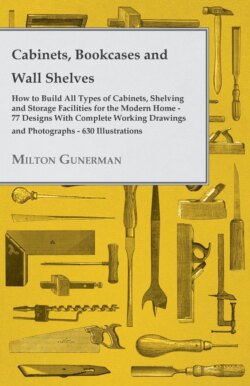Читать книгу Cabinets, Bookcases and Wall Shelves - Hot to Build All Types of Cabinets, Shelving and Storage Facilities for the Modern Home - 77 Designs with Compl - Milton Gunerman - Страница 12
На сайте Литреса книга снята с продажи.
Modern Bow-Front HAMPER
ОглавлениеEven a Utility Piece Can Have Pleasing Style as Demonstrated by the Hamper Presented Here for Construction in the Home Workshop at Low Cost
AN EXTREMELY useful and attractive bathroom hamper can be made with a few simple tools and low-cost materials. If plywood and fiberboard are difficult to obtain for the front and back, wallboard of the compressed paper variety may be substituted. Since a lightweight hamper is desirable, the plans are based on 1/8″ material for the back and front panels. However, 1/4″ paneling can be substituted, and adjustment made in cutting the other members. As a matter of fact, if wallboard is used, it should be at least 1/4″ thick.
The sides of the hamper are made of two pieces of 3/4″ pine 10 1/8″ wide and 23 1/4″ long. The front edge of each piece is beveled as shown in the top view to conform with the sweep of the front panel. The bevel extends back 3/8″ on the outside face of the side member. The back edge of these pieces has a 1/2″ × 1/8″ rabbet cut to take the back panel. If the panel used is 1/4″ thick, this rabbet will have to be 1/4″ deep. The front and back top rails are set into gains cut in the upper end of each side piece. The gain for the back rail is 3/4″ × 1″ and is cut 1/2″ deep. The gain for the front rail is the same size but it must be laid out parallel to the bevel of the front edge.
The bottom is made of 3/4″ stock 11 3/4″ wide and 22 1/2″ long. If a 1/4″ back panel is used the bottom should be finished to a width of 11 5/8″. The forward edge of the bottom member must be curved. To lay out this sweep the location of the forward edge of the side members must be established on the bottom. This point is either 10″ from the back edge or 9 7/8″ depending on whether a 1 1/8″ or 1/4″ panel is used. The arc is drawn with the aid of a thin strip of wood bent to join these two outside points and forward edge of the board at the center. The marked edge is shaped with a plane and spokeshave.
The top front rail is made of 3/4″ stock 3″ wide and 23 1/2″ long. The forward edge should have the same sweep as that of the bottom piece and can be marked by tracing the curve from the bottom piece. After the forward edge of the top rail has been shaped, a line is gauged 1″ from this curved edge and parallel to it throughout its length. The concave inner edge is produced by cutting the stock with a coping or keyhole saw and finishing with a spokeshave.
The pieces can now be assembled to produce the framework of the hamper. Eightpenny finishing nails should be used. One of the photographs shows these members assembled and ready for front and back panels. If the bevel on the forward edge of the side members does not conform with the sweep of the arc final planing will correct the work as in the second construction photograph.
The back panel is cut to size and fitted in place. Air holes near the top and bottom of this panel should be located and bored before the panel is fastened in place with twopenny nails. The front panel should be cut wider than is actually needed; the excess can be trimmed off after the panel is in place. The front panel should be fastened with 1″ brads along the entire edge of one side member first. It is then bent over the frame and fastened along the other edge.
The top overhangs the case on three sides and is made of 3/4″ stock: one piece is 1 1/8″ wide by 25″ long, while the other piece is 11 3/8″ × 25″. The narrow piece is fastened permanently to the case, over the back rail. The wide piece has its forward edge shaped to conform with the sweep of the cabinet front. The cover is hinged with 2″ brass butts. The handles are made of two pieces of 1 3/4″ round stock 4″ long with one surface flattened.
The photo above shows how the two top rails and the bottom panel join the side members to form the casa of the hamper. Notice the curved front rail and bottom
Top photo illustrates how the sides may need final trimming to farm a fair curve. Below, C clamps help to hold the panel in place while it is being nailed to sides
